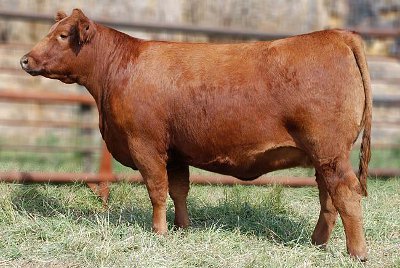Red Angus Cattle
Category: Cattle - Cow

Facts about Red Angus Cattle, Just like the many other beef breed, the Red Angus Cattle began in Europe. It has all the attributes of Angus but with the addition of the red coat. The Red Angus Cattle excels for their temperament, carcass characteristics and maternal qualities. The "Fear of cattle Bovinophobia". "Scientific name for cattle Bovine".
The Red Angus Cattle is preferred in the tropical based areas; this is because the red color reflects the sunlight better as compared to the darker breeds aiding in handling the extreme heat conditions. The Red Angus Cattle will also flourish in buffalo fly infested areas because the fly is attracted mostly to the black hided cattle.
Description
The Red Angus Cattle is a medium-sized breed with a beefy carcass, and they got soundness throughout the legs and feet. It’s obviously red in color, naturally polled. When the Red Angus Cattle breed is crossed with another breed, the red color is dominant as it is passed to the resulting off-spring.
Characteristics
The Red Angus Cattle is resistant to harsh weather; they are adaptive to environment, undemanding, and good in nature. The Red Angus Cattle matures very early, having higher carcass yield and the meat is nicely marbled. The Red Angus Cattle are popularly known for its carcass and are mostly used in breeding in order to improve the carcass quality and milking in the cows. The cows will calve very easily, and have good maternal qualities. The Red Angus Cattle can also be used as genetic DE-horner as the polled gene is dominant and will be passed to the next generation.
Temperament
The Red Angus Cattle breed is considered to be very gentle and easy to handle. The docile nature of the Red Angus Cattle is known worldwide. Breeders know that poor temperament will reduce profitability; this is due to the cost one will have to employ so as tame the animal. And that is one of the important character that the Red Angus Cattle holds over many breeds.
Health Issues
Just like every other livestock, Red Angus Cattle will require regular vaccinations and inoculation programs for example rabies inoculations. Ensure regular checkups to prevent ailments and other health issues related to the cattle.
Diet
There is not much to the diet than normal grazing land with plenty of pasture. If a pasture is not enough you can always supplement with hay. Other supplements include protein, mineral cubes, grain mixes, and salt blocks – and this depends on the sex of the cow, the use of the supplement and definitely the local climate.
Plenty of fresh and clean water is a necessity; provide at least 20 gallons (75 liter) per cow per day and their consumption will vary with the general weather conditions.
Beef is consumed through out the world. Beef is eaten as roasts, steaks, and hamburgers. The other way it is used is meat by-products, this includes brains, intestines, horns, hides, diaphragm, heart, hoofs, hair, lips, snout, ears, bones and tongue. These meat by-products are used in many products that include margarine, dog food, makeup, chewing gum, marshmallows, shampoo, ice cream, gelatin, cement, chalk, and tennis racquets, fertilizer, piano keys, glues, wallpaper and strings for musical instruments. There are three different phases the way Beef is raised, the calves are raised on farm land and out in the pasture, used as feeder cattle they feed in the pasture on grass and crop residue. Finally the beef goes to troughs of feed, where the beef is fattened to be slaughter. The slaughterhouse is where the beef gets cut up and divided into different cuts, the (meat packer). This is were it is packed and sent to meat distributors where it goes to butchers and super markets.

 Back To Category Cattle - Cow
Back To Category Cattle - Cow